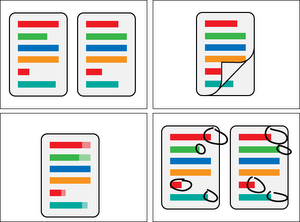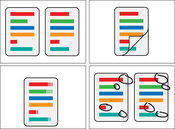Information
- Publication Type: PhD-Thesis
- Workgroup(s)/Project(s):
- Date: June 2016
- Date (Start): 2011
- Date (End): 2016
- TU Wien Library:
- 1st Reviewer: Eduard Gröller
- 2nd Reviewer: Stefan Bruckner
- Rigorosum: 28. June 2016
- First Supervisor: Eduard Gröller
Abstract
The comparison of two or more objects is getting an increasingly important task in data analysis. Visualization systems successively have to move from representing one phenomenon to allowing users to analyze several datasets at once. Visualization systems can support the users in several ways. Firstly, comparison tasks can be supported in a very intuitive way by allowing users to place objects that should be compared in an appropriate context. Secondly, visualization systems can explicitly compute differences among the datasets and present the results to the user. In comparative visualization, researchers are working on new approaches for computer-supported techniques that provide data comparison functionality. Techniques from this research field can be used to compare two objects with each other, but often reach their limits if a multitude of objects (i.e., 100 or more) have to be compared. Large data collections that contain a lot of individual, but related, datasets with slightly different characteristics can be called ensembles. The individual datasets being part of an ensemble are called the ensemble members. Ensembles have been created in the simulation domain, especially for weather and climate research, for already quite some time. These domains were greatly driving the development of ensemble visualization techniques. Due to the availability of affordable computing resources and the multitude of different analysis algorithms (e.g., for segmentation), other domains nowadays also face similar problems. All together, this shows a great need for ensemble visualization techniques in various domains. Ensembles can either be analyzed in a feature-based or in a location-based way. In the case of a location-based analysis, the ensemble members are compared based on certain spatial data positions of interest. For such an analysis, local selection and analysis techniques for ensembles are needed.In the course of this thesis different visual analytics techniques for the comparative visualization of datasets have been researched. A special focus has been set on providing scalable techniques, which makes them also suitable for ensemble datasets. The proposed techniques operate on different dataset types in 2D and 3D. In the first part of the thesis, a visual analytics approach for the analysis of 2D image datasets is introduced. The technique analyzes localized differences in 2D images. The approach not only identifies differences in the data, but also provides a technique to quickly find out what the differences are, and judge upon the underlying data. This way patterns can be found in the data, and outliers can be identified very quickly. As a second part of the thesis, a scalable application for the comparison of several similar 3D mesh datasets is described. Such meshes may be, for example, created by point-cloud reconstruction algorithms, using different parameter settings. Similar to the proposed technique for the comparison of 2D images, this application is also scalable to a large number of individual datasets. The application enables the automatic comparison of the meshes, searches interesting regions in the data, and allows users to also concentrate on local regions of interest. The analysis of the local regions is in this case done in 3D. The application provides the possibility to arrange local regions in a parallel coordinates plot. The regions are represented by the axes in the plot, and the input meshes are depicted as polylines. This way it can be very quickly spotted whether meshes produce good/bad results in a certain local region. In the third and last part of the thesis, a technique for the interactive analysis of local regions in a volume ensemble dataset is introduced. Users can pick regions of interest, and these regions can be arranged in a graph according to their similarity. The graph can then be used to detect similar regions with a similar data distribution within the ensemble, and to compare individual ensemble members against the rest of the ensemble. All proposed techniques and applications have been tested with real-world datasets from different domains. The results clearly show the usefulness of the techniques for the comparative analysis of ensembles.
Additional Files and Images
Weblinks
No further information available.BibTeX
@phdthesis{schmidt-phd,
title = "Scalable Comparative Visualization",
author = "Johanna Schmidt",
year = "2016",
abstract = "The comparison of two or more objects is getting an
increasingly important task in data analysis. Visualization
systems successively have to move from representing one
phenomenon to allowing users to analyze several datasets at
once. Visualization systems can support the users in several
ways. Firstly, comparison tasks can be supported in a very
intuitive way by allowing users to place objects that should
be compared in an appropriate context. Secondly,
visualization systems can explicitly compute differences
among the datasets and present the results to the user. In
comparative visualization, researchers are working on new
approaches for computer-supported techniques that provide
data comparison functionality. Techniques from this research
field can be used to compare two objects with each other,
but often reach their limits if a multitude of objects
(i.e., 100 or more) have to be compared. Large data
collections that contain a lot of individual, but related,
datasets with slightly different characteristics can be
called ensembles. The individual datasets being part of an
ensemble are called the ensemble members. Ensembles have
been created in the simulation domain, especially for
weather and climate research, for already quite some time.
These domains were greatly driving the development of
ensemble visualization techniques. Due to the availability
of affordable computing resources and the multitude of
different analysis algorithms (e.g., for segmentation),
other domains nowadays also face similar problems. All
together, this shows a great need for ensemble visualization
techniques in various domains. Ensembles can either be
analyzed in a feature-based or in a location-based way. In
the case of a location-based analysis, the ensemble members
are compared based on certain spatial data positions of
interest. For such an analysis, local selection and analysis
techniques for ensembles are needed. In the course of this
thesis different visual analytics techniques for the
comparative visualization of datasets have been researched.
A special focus has been set on providing scalable
techniques, which makes them also suitable for ensemble
datasets. The proposed techniques operate on different
dataset types in 2D and 3D. In the first part of the thesis,
a visual analytics approach for the analysis of 2D image
datasets is introduced. The technique analyzes localized
differences in 2D images. The approach not only identifies
differences in the data, but also provides a technique to
quickly find out what the differences are, and judge upon
the underlying data. This way patterns can be found in the
data, and outliers can be identified very quickly. As a
second part of the thesis, a scalable application for the
comparison of several similar 3D mesh datasets is described.
Such meshes may be, for example, created by point-cloud
reconstruction algorithms, using different parameter
settings. Similar to the proposed technique for the
comparison of 2D images, this application is also scalable
to a large number of individual datasets. The application
enables the automatic comparison of the meshes, searches
interesting regions in the data, and allows users to also
concentrate on local regions of interest. The analysis of
the local regions is in this case done in 3D. The
application provides the possibility to arrange local
regions in a parallel coordinates plot. The regions are
represented by the axes in the plot, and the input meshes
are depicted as polylines. This way it can be very quickly
spotted whether meshes produce good/bad results in a certain
local region. In the third and last part of the thesis, a
technique for the interactive analysis of local regions in a
volume ensemble dataset is introduced. Users can pick
regions of interest, and these regions can be arranged in a
graph according to their similarity. The graph can then be
used to detect similar regions with a similar data
distribution within the ensemble, and to compare individual
ensemble members against the rest of the ensemble. All
proposed techniques and applications have been tested with
real-world datasets from different domains. The results
clearly show the usefulness of the techniques for the
comparative analysis of ensembles.",
month = jun,
address = "Favoritenstrasse 9-11/E193-02, A-1040 Vienna, Austria",
school = "Institute of Computer Graphics and Algorithms, Vienna
University of Technology ",
URL = "https://www.cg.tuwien.ac.at/research/publications/2016/schmidt-phd/",
}



